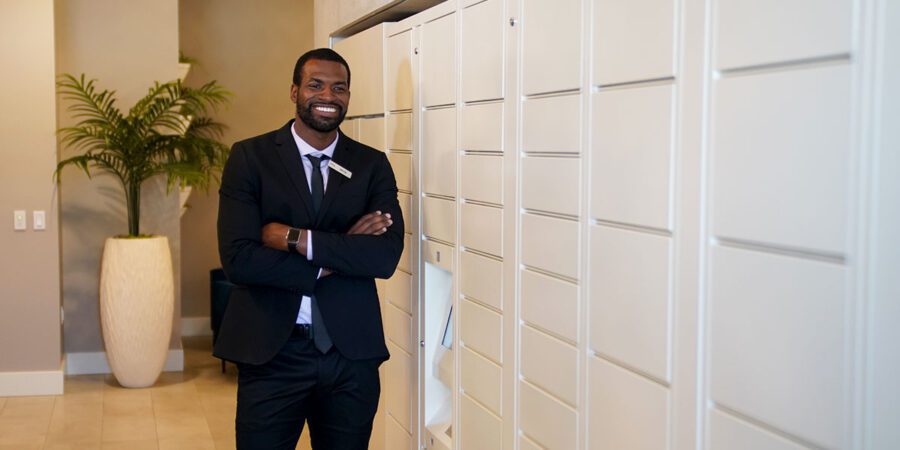Multifamily
Multifamily Housing Trends All Community Managers Should Be Aware Of
Written by: Parcel Pending
9 Min Read
Published: August 26, 2019
Updated: March 29, 2023
We live in a quicksilver world that’s constantly changing and expanding. The rise of the digital age has sped up that process by significantly altering consumer behavior and shifting demand. This is especially true in the multifamily housing market of, which has continued to experience rapid growth and evolution over the past two decades. Now, renters are more demanding and pickier about the space they choose to live in than ever before. As a result, what might have worked to entice renters in the past, no longer has the same effect. So, what are some effective resident retention ideas or property management tips you can utilize?
As a property manager or multifamily building owner, you can check multifamily housing market trends and how they could impact your property and the future of apartment living. Failing to respond to shifts in consumer demand and the real estate market movement could very well result in vacant rooms and lost revenue. Want to stay on top of your game? Read on and discover our multifamily trends to watch so that you’re prepared to react quickly and effectively.
Multifamily Housing Trends to Be Aware of
The Economy is Booming
As 2019 approaches its close, America continues to show unprecedented economic growth. Since the end of the Great Recession in 2009, economic expansion has continued for a decade now. This recently broke the record for the longest expansion without a recession in American history. While experts warn of an impending slowdown, President Trump’s economy has continued to surprise, leading to benefits for Americans of all socioeconomic status.
Some statistics that illustrate just how good this economy is include:
- Employment has grown for 100 straight months, resulting in 20,000,000 new jobs created.
- In May, unemployment fell to 3.6%, hitting the lowest figure since 1969 and reaching what is considered to be full employment.
- Black and Hispanic unemployment are the lowest they’ve ever been.
- Wages are rising at the fastest rate in nearly a decade with an annual increase of 3% to 4%
For property managers, the booming economy is a great thing. More money in everyone’s pocket means more people are looking to rent, especially in that all-important 20- to 34-year-old demographic, who currently sit at 4.5% unemployment. Since more than 2 out 3 of men and women within this age range rent, this prosperity will lead to increased apartment demand. With that in mind, it also means that there’ll likely be more competition in the rental market with increasing numbers of parties interested in joining the apartment owning scrum in order to make money off the increased number of people searching for places.
Increased wages typically correspond with a willingness to spend more on a multifamily unit. As a result, renters are able and prepared to pay higher rent for better features. The millennial generation especially is willing to spend more on apartments that come with luxurious amenities or additional conveniences. With so much competition in the multifamily rental market, it’s essential that you do everything in your power to help distinguish your apartment units from others.
Don’t Worry About Oversupply of Multifamily Housing Units
Although rising wages and job growth have encouraged more builders and apartment owners to enter the fray, experts forecast that the supply of multifamily housing units won’t outpace the demand for such units. According to Reuters:
U.S. apartment vacancy rate was flat in the first quarter, with vacancy rising in only 15 of 79 metros, real estate research firm Reis Inc said on Thursday. The national vacancy rate was 4.8 percent, unchanged from the fourth quarter and marginally up from 4.7 percent a year earlier… Net absorption fell about 21.6 percent to 37,159 units in the first quarter from a year earlier, while new construction dropped 40.6 percent to 33,276 units.
It seems that we’ve reached the turndown point in apartment market growth, which has seen record numbers over the past 5 years. This is likely due to several factors, including:
- Decreased construction permit volume.
- Harder to build new apartments because of increased construction inputs and labor costs.
- Construction labor shortage.
Despite the fact that there are on average 245,000 units absorbed yearly and that rent has risen 4% to 5%, it seems that there hasn’t been any serious impact on the underlying demand for units. As a result, oversupply shouldn’t pose any serious issue over the next 4 to 5 years.
Renters Demand Modern Amenities
One critical trend that property managers should be aware of is that young people are renting more frequently and for longer periods of time than ever before. They care less about homeownership and more about investing in a place that manages a balance between affordability and amenities. Further, they are more willing to relocate to an apartment complex that offers additional features or conveniences.
The PwC and Urban Land Institute issued a report on emerging real estate trends in 2019. One of their biggest takeaways is that there is a serious increased demand for amenities. The report states:
The chief strategist for one major developer reports that, ‘tenants continue to push for a robust amenities package” in new office buildings and that multifamily assets have gone well beyond the fitness center and recreational areas to include pet care and even a curated garden growing fresh fruits and vegetables. Every year it is something new. We’ve gone from a ‘package room’ to accommodate all-day deliveries, to lockers, to refrigerated spaces for food—both grocery and prepared foods—that need to be kept fresh.’ For some, this extends to concierges with keys to the unit, who will do the last steps in individualized convenience.
In order to entice new renters into your building, it’s essential that you create a space that is inviting and goes beyond simply providing them with a drab room. The trend of more people working from home has resulted in an increased demand for communal and coworking spaces. These days, common amenities of apartment units include:
- Smart-home Tech – Young people especially have embraced the modernizing of the home. Consider adding features such as:
-
- Smart Lights
- Smart detectors
- Automated doorbells and security systems
- Alexa or Google Home speaker integration
- Keyless entry
- Parcel Lockers – Today, a significant majority of Americans do the plurality of their shopping online. As is illustrated by the absurd growth of Amazon over the last decade, people, particularly younger people, regularly do both their personal and grocery shopping digitally. This has resulted in a massive influx of packages that either have to be delivered to their door or that complexes need to manage. Naturally, this has resulted in an increased outbreak of package theft.
Seeing this rise in both deliveries and thievery, many apartment complexes have made the smart investment to install smart electronic lockers in order to eliminate their tenants’ concerns about their packages being delivered safely. Parcel Pending also offers a range of parcel locker options like apartment package lockers and Lite Lockers, a solution for smaller apartment communities.
Such modern luxuries provide the following benefits:
-
- Infrared scanning and categorization for easy sorting and storage.
-
- Refrigerated lockers so groceries and pharmaceuticals can be kept safe and cooled at the proper temperature.
-
- Cloud-based 24/7 video surveillance and security.
-
- Deliverability via any courier service.
- Communal Spaces and Time Savers – Prospective renters want flexible work and gathering areas as well as luxurious communal occupational spaces. They don’t want just a space to sleep, they want a space to live in. Renters desire a sense of community and the opportunity to build relationships with other tenants in the area.
This could include:
-
- Pool
- Coffee shop
- Spa
- Conference rooms
- Pool rooms
- Gym
- Pet cleaning stations
- Park areas
- Dry cleaning services
All of these spaces can be placed in the pros column when a person is weighing their living options. As they compare and contrast spaces, conveniences such as these could be the deciding factor. It’s one less extra thing they have to pay for or drive to. As a complex manager, your goal should be to turn your multifamily housing unit into an oasis that tenants don’t ever have to leave unless they want to.
- High-End Security – Despite decreased crime rates, security is a rising concern for renters. They desire vigilant protection and safety in order to have peace of mind and feel like the complex is their home. Ways to protect the community include:
-
- 24/7 security and monitoring.
-
- Regular security guard patrolling.
-
- Gates and fences around the complex and parking areas.
-
- Cameras set up on the premises.
-
- Electronic fobs with auto-locked entrances and exits.
Curb Appeal Matters More Than Ever
What may have always worked in the past world of multifamily housing no longer does. Prior to the new millennia, you used to be able to get away with simply build a drab and undistinguishable apartment complex without needing to be overly concerned about how it looked. An apartment was a place to live, nothing more. Now, that soviet, central planning, cinderblock style of design will no longer work; renters are more discerning and have increased options at their disposal.
These days, new apartments are constructed with curb appeal and luxury in mind. The outside matters as much as the inside, particularly for long-term renters that want to live in a place they are proud of and that feels like home. According to the American Institute of Architects, this multifamily housing trend design is known as Urban Elegance, which is defined as, “Clean, sleek aesthetics continue to adorn multifamily buildings across urban skylines nationwide. Large expanses of glass, with seamless transitions between floors (and from interior to exterior spaces) are often used to achieve this desired appearance.”
So, if you’re planning on building a new multifamily housing complex, it’s critical that you keep outward appearances in mind. You could have the nicest rooms ever made, but if the outside of the building looks like a dive, you’ll have an incredibly difficult time convincing prospective tenants to even tour the building. Unfortunately, people often judge the book by its cover.
Apartment Complexes are Going Green
Today, new multifamily units have sustainability and ecological impact at the forefront of their design. Nearly every unit will include some sort of green features. As a result, an increasing amount of older buildings are being retrofit or redone to incorporate green tech into their current design. Millennials and Gen Z’ers especially care about their footprint on the environment and want to live in a place that echoes their concerns.
According to the 2017 NMHC/Kingsley Renter Preferences Report:
- Approximately two-thirds, 61%, of renters said that they were “interested” or “very interested” in living in apartment buildings that have earned a certification for energy efficiency or sustainable design.
- Approximately three-quarters, 76%, of renters were “interested” or “very interested” in living in apartment buildings that recycle and have sustainability initiatives.
The modern renter doesn’t just want green living, they expect it. Tenants reported that they are willing to pay an extra $27.21 a month to live in a building that has green certifications. They demand features such as:
- Healthy indoor air
- Clean water
- Decreased waste
- Energy efficiency
- Solar panels.
With this in mind, it’s critical that you keep this consumer demand for green living in mind, particularly if you operate in large, liberal, coastal cities such as Los Angeles, San Francisco or New York City. Failure to respond to this could instantly turn off many potential tenants.
Moving into 2020
As 2019 multifamily housing trends indicate, the modern renter plans to rent for longer than ever. Accordingly, they desire an apartment that feels like home. As a complex manager or property owner, it’s your job to act on these demographic shifts in order to attract new renters. By keeping such factors in mind, you can ensure that both your current residents are happy and that prospective tenants compete to land one of your units.
Sources:
- Schwartz, N. New York Times. Job Growth Underscores Economy’s Vigor; Unemployment at Half-Century Low. (2019). https://www.nytimes.com/2019/05/03/business/economy/jobs-report-april.html
- Long, H. Washington Post. U.S. Unemployment Fell to 3.6 Percent, Lowest Since 1969. (2019). https://www.washingtonpost.com/business/2019/05/03/us-economy-added-jobs-april-unemployment-fell-percent-lowest-since/?utm_term=.f28c1d34fc8f
- Rooney, K. CNBC. Black Unemployment Rate Falls to 5.9%, Ties Record Low Hit Earlier This Year. (2018). https://www.cnbc.com/2018/12/07/black-unemployment-rate-falls-to-5point9percent-ties-record-low-hit-this-year.html
- Morath, E. Wall Street Journal. Wages Rise at Fastest Rate in Nearly a Decade as Hiring Jumps. (2018). https://www.wsj.com/articles/wages-rise-at-fastest-rate-in-nearly-a-decade-as-hiring-jumps-in-october-1541161920
- Bureau of Labor Statistics. Labor Force Statistics from the Current Population. https://www.bls.gov/web/empsit/cpsee_e16.htm
- Reuters. U.S. Apartment Vacancy Rate Flat at 4.8 percent in First Quarter. (2019). https://www.reuters.com/article/us-usa-property-apartment/us-apartment-vacancy-rate-flat-at-48-percent-in-first-quarter-reis-idUSKCN1RA0AD
- PWC. Emerging Trends in Real Estate. (2019). https://www.pwc.com/us/en/asset-management/real-estate/assets/pwc-emerging-trends-in-real-estate-2019.pdf
- Kawneer. American Institute of Architects. Meeting Modern Trends in Multifamily Construction. (2018). https://www.aia.org/articles/212456-meeting-modern-trends-in-multifamily-constr
- National Multifamily Housing Council. 2017 NMHC/ Kingsley Apartment Renter Preferences Report. https://www.nmhc.org/research-insight/research-report/2017-nmhc-kingsley-apartment-renter-preferences-report/
- Building Design + Construction. In Many Markets, Green Features are More of a Requirement for Apartment Renters. (2018). https://www.bdcnetwork.com/many-markets-green-features-are-more-requirement-apartment-renters



